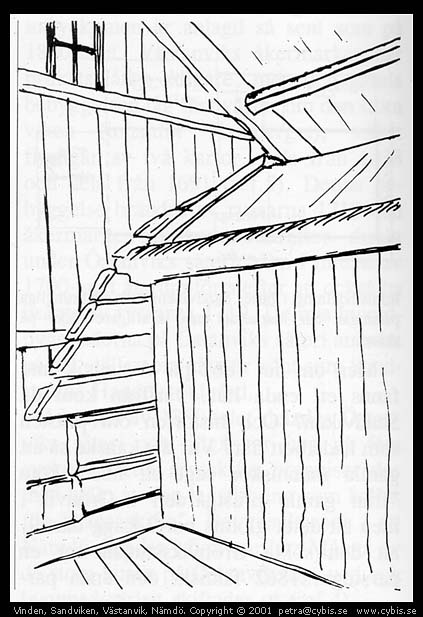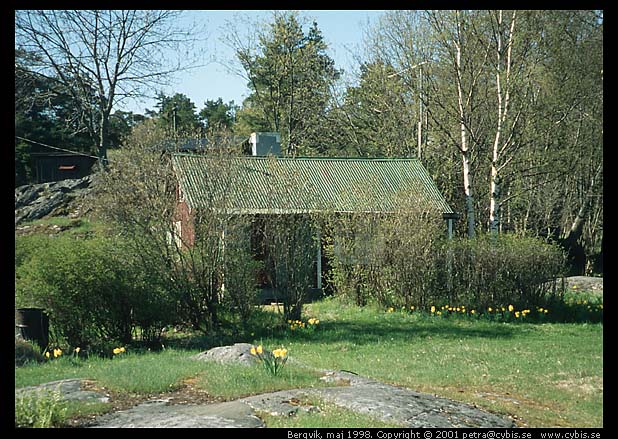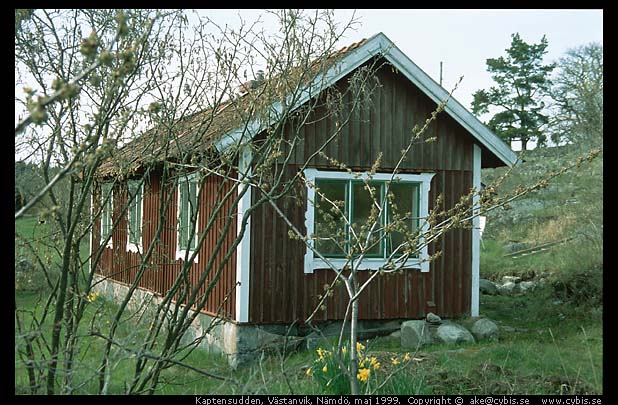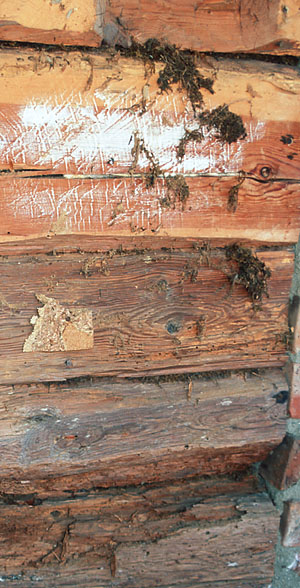Sandviken, Västanvik, Nämdö

A map from 1865 originating from the partition of the manorial estate Östanvik at Nämdö showed no houses at all here. But there has always been a question if the house was excluded from the map because it was privately owned and did not part in the partition.

In the attic we can see the adjacent room in the old mansard superstructure as a separate building inside the house.
- When considering where the samples were taken in the house we conclude that
- the major part of the house was built by loggs from 1769.
- the house was moved to this place in 1867.
- logs from 1748 are replacements of decayed logs inserted when the house was re-erected here.
The 1748 loggs probably come from the old mansion at Östanvik which was built around 1750 and was
dismounted around 1865 and distributed among the heirs.
- the house was enlarged in 1893 probably with the intension to let the house to summer visitors, the new way at that time to get some ready money.
Complicated? Yes, but it takes down a lot of local historical speculations to more of reality.
A more detailed article about the house and the dating is available in Swedish.
Bergvik, Nämdö


I took a lot of samples from the old house. They were infested with mildew and very unhealthy to work with! The dendrochonological analysis revealed that the house was built by logs cut in the winter season 1875/76.
This fits in with the local history. The old church at Nämdö was located quite a long way from here. A new church was opened near this place in 1876, the same year as this house was built for the sexton.
The old school house, Sand/Grönvik, Nämdö

A dendrochronological analysis by Lars Löfstrand in Uppsala revealed that the house was built with logs cut in the winter 1869/70. So this was obviously built as a school house, though it was quickly found to be too small. Building of still a new bigger school house started around 1908.
Kaptensudden, Västanvik, Nämdö


When the house was demolised one year later, I took a number of samples for dating.
Results of the dating:
- The youngest sample (log) is sawn lengthwise. It was cut in the winter 1895/96.
This probably means that the extra room was added to the house in 1896 or 1897.
- one log from Nämdö dated to 1856
- one log from Nämdö dated to 1860, both with bark surface (wane).
- two probably reused logs from Nämdö (from an older building) where sapwood is cut away and where the outer parts correspond to the years 1787 and 1779. I cannot determine how much sapwood was cut away. Perhaps these logs come from a house built around 1820.
Most samples (17) come from logs which were cut in the winter 1870/71. These logs did not grew like timber from Nämdö. They can however easily be dated towards a reference curve from Nämdö. Probably these logs come from the mainland or from another part of the archipelago.
In addition to this I have found
The selection of logs for sampling was limited by the fact that most logs were in bad condition because of woodworm and decay.
All wood in the outer walls had a silver lustre saying that probably the house had been standing some years without covering boards.
All datings are reliable. The dated ring width measurements have all been delivered to the ITRDB (swed303.rwl).
Speculating on two possible scenarios
Alternative 1: The house was built at Västanvik 1871 with logs bought from elsewhere.
The tale saying that the house was taken from Skärvassa may come from that some logs were
taken from a then 50 year old barn at Skärvassa.
In 1896 an extra room was added to make the house more suitable for renting to summer visitors.
Alternative 2: The story about a man, Melander, living on the island of Tjeckskär North of Skärvassa
is the basis of the Skärvassa tale.
Perhaps Melander built his house in 1871 with logs bought from elsewhere.
He could not buy logs from Nämdö, because all available wood was needed when building the new farms on the island.
He also used logs from an old barn he already had.
Later on the house was moved to Västanvik because its owner died and the house was standing on ground belonging to the Västanvik farm.
In 1896 the extra room was added.
Possibly we can check the parish register to see if there was actually a man living on Tjeckskär - and when he died. Something which makes things difficult is that the name Melander is connected to Tjeckskär/Skärvassa as well as to the house Sandviken at Västanvik and also to Grönvik. Perhaps there were more than one Melander living on Nämdö at this time.
To sum up, we have not yet found a really reliable story about this house!